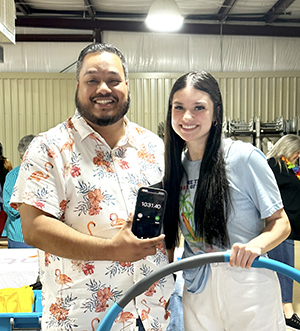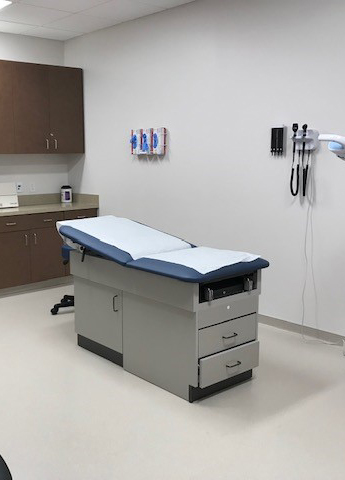County Magazine | July 31, 2023
Want a healthy workforce? Consider an employee clinic
Job security, reliable retirement benefits and service-oriented work are among the perks of working for a Texas county, but for many, there's an additional advantage – a health clinic just for employees.
Several Texas counties have set up clinics that offer visits for thousands of employees, their dependents and retirees at a $0 copay. Convenient hours, the ability to avoid using sick days for visits and quality health management are other bonuses of the service. For county leaders, employee clinics are a lofty undertaking, but one that they hope will translate into long-term cost-savings, improved employee productivity and retention, and most importantly, a healthier and happier workforce.

one-year anniversary of the facility's opening.
(Credit: Brazos County)

left, and Chambers County summer intern Madison
Cooper, right, attend the Chambers County employee
health fair in June. The employee wellness clinic
regularly shares information with employees about
TAC's wellness programs. (Credit: Chambers County)

Employee Health & Wellness Clinic.
(Credit: Brazos County)
"We can catch things and be more proactive and preventative with their health and their wellness," said Brazos County human resources director Jennifer Salazar. "It's a tremendous benefit."
Brazos County opened its clinic in 2017 after mulling the idea for a decade. The county had explored partnering with the city and school district to open a clinic for all its employees but opted to create its own by hiring a nurse practitioner to serve as a medical manager and renovating the old tax office building.
The clinic serves 1,700 covered members, providing wellness visits, vaccinations, urgent care appointments and lab work.

(Credit: Chambers County)
Clinic model
At least 16 employee clinics in the state are run by governmental entities, according to the National Association of Worksite Health Centers. About a dozen of them are in Texas counties, according to the Texas Association of Counties (TAC).
Three major models of employee clinics exist: those run by a single local governmental entity, those run by multiple governmental entities, and those operated by a local hospital or medical group.
Tom Green County's system falls into the third category. The three clinics, operated by Shannon Health, do not solely serve county employees and are open seven days a week from 7 a.m. to 7 p.m. Employees also do not have to pay a copay, and the user fee the county pays per individual is less than what a typical copay would cost.
"They don't necessarily have to wait to try to get an appointment to see their primary care physician or another doctor to get some immediate relief," said Julie Ratekin, Tom Green County's human resources director.
Like other county employee clinics, Chambers County's clinics can be used by employees, dependents and eligible retired employees on the county's plan, a total of about 1,000 people.
Services offered include acute care, sick visits, virtual visits, physicals, chronic disease management, primary and preventive care, smoking cessation, women's health care and specialty care referrals.
Both Brazos and Chambers counties further maximize their investments in their clinics by sharing their medical staffs with their jails. That means Brazos' medical team, in addition to employees, has 727 inmates to care for, and Chambers has about 170 inmates.
Chambers County's clinic also serves eligible indigent residents.
"We see tremendous economies of scale, which serves as a 'win-win' providing care for our inmates as well as providing care for our employees and their families," Salazar said.
Return on investment
For every dollar spent, organizations that have employee clinics can see about $1.50 in savings, according to Larry Boress, executive director of the National Association of Worksite Health Centers.
Worker productivity, satisfaction and retention improve. Sick time and claims are reduced. And, employees are connected to other wellness programs like those offered within TAC Health and Employee Benefits Pool's Healthy County.
"We can catch things and be more proactive and preventative with their health and their wellness."
— Jennifer Salazar, Brazos County human resources director
"Clinic staff can promote, encourage and recommend programs and services available to employees that are offered through the Healthy County program," said Ashley Cureton-Whitfield, a TAC Wellness Consultant. "We also will partner with the clinic for health and wellness events for employees, such as health fairs, flu clinics, biometric screenings and lunch-and-learns."
The clinics' providers can also spend more time with patients, offering more individualized care and earning their trust, Boress said. For working parents, the clinics have also been a convenient way for their children to obtain physicals, immunizations or to have illnesses diagnosed.
"We find 40% to 60% of people who use these centers don't have a personal doctor, so it really becomes their primary medical home," Boress said.
Brazos County's annual budget for its clinic is about $500,000. Although the county does not track data on cost savings from the clinic, Salazar says lives are being saved, a benefit that can't be measured.
"I know of employees who happened to feel a bump, and they went to the clinic," Salazar said. "While the clinic didn't necessarily catch it or diagnose it, it did end up being cancer. They directed them to the proper care."
In Chambers County, the clinic, which has two nurse practitioners, has caught cancer in patients, in addition to blood clots, irregular heartbeats and diabetes, among other illnesses.
"In the past 16 years of our clinic's operations, we have identified life threatening conditions and cancer in healthy or well patients, just by performing their routine physical," said Mary Beth Bess, Chambers County's health services director and a nurse practitioner.
How to start a clinic
Before agreeing to establishing an employee clinic, a county must have the approval of its commissioners court, Bess said. Hard questions must be asked, including whether there will be a return on investment. Are there enough employees to justify the cost? Will they use the clinic? How will success be measured?
"If it weren't for the commitment from our commissioners court…as well as the funding in the budget, and the trust of our patients, we wouldn't be successful," Bess said, adding that because of the clinic's location, the ability for employees to utilize the services and return to work is a plus for employees and a cost savings for the county.
Next steps are visiting other county employee clinics and determining kinds of services that should be offered. Bess had visited with several county and employer-owned clinics before making recommendations. One included a county that initially offered only sick visits and later expanded to primary care services.
For counties interested in a third party to run their clinics, commissioners courts should interview the medical providers to ensure expectations will be met, Boress said. County leaders should also be using the clinic, he said.
"The thing that kills the centers is word of mouth about poor provider-patient experiences and relationships," Boress said.
Before opening their clinic, the Chambers County medical staff met with every department to provide an overview of the services provided, asking employees what they needed and expected out of a clinic that would make them want to visit it. They also addressed concerns about privacy surrounding their health information.
"It was a real and valid concern of employees of having their health information protected from others such as supervisors or leadership, since it was a county owned clinic. Reassurance on privacy was given at that time and continues today," Bess said.
Obtaining and maintaining trust is the foundation of the clinic, Bess said.
"We know that a healthy workforce is a more productive workforce, and we strive to not only provide outstanding primary care services to our patients, but continually engage them in wellness activities that will benefit them even after they retire," Bess said.

